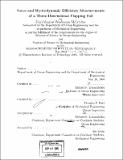| dc.contributor.advisor | Michael S. Triantafyllou and Douglas P. Hart. | en_US |
| dc.contributor.author | McLetchie, Karl-Magnus Weidmann | en_US |
| dc.contributor.other | Massachusetts Institute of Technology. Dept. of Mechanical Engineering. | en_US |
| dc.date.accessioned | 2006-07-13T15:24:18Z | |
| dc.date.available | 2006-07-13T15:24:18Z | |
| dc.date.copyright | 2004 | en_US |
| dc.date.issued | 2004 | en_US |
| dc.identifier.uri | http://hdl.handle.net/1721.1/33437 | |
| dc.description | Thesis (S.M.)--Massachusetts Institute of Technology, Dept. of Ocean Engineering; and, (S.M.)--Massachusetts Institute of Technology, Dept. of Mechanical Engineering, 2004. | en_US |
| dc.description | Includes bibliographical references (p. 69-70). | en_US |
| dc.description.abstract | Investigations into unsteady flapping foil propulsion have shown that it is an efficient and high thrust means of propulsion. Extensive work has been done to optimize the efficiency of two-dimensional flapping foils, varying both the kinematics of the motion and the flexibility of the foil. However, no thorough investigation into the hydrodynamic efficiency of three-dimensional flapping foils has been made. In this thesis, experimental hydrodynamic efficiency measurements and force measurements of a three-dimensional flapping foil are presented. These measurements were made by mounting a small, six-axis dynamometer directly onto the foil shaft of a flapping foil module. The module uses two computer controlled servo motors to actuate a foil in a sinusoidal pitch and roll motion, similar to the motion of a penguin's wing. The measured thrust coefficients compared well to previous experimental results, and the on-shaft dynamometer proved to be a valuable sensor. However, the experimental apparatus must be modified before reliable efficiency results can be made for the entire range of kinematics. | en_US |
| dc.description.abstract | (cont.) Once these improvements are made, a thorough investigation into the effects of foil geometry and flexibility can be done to find the optimum efficiency parameters of a three-dimensional flapping foil. These optimum efficiency parameters will be valuable for the development of flapping foil vehicles. | en_US |
| dc.description.statementofresponsibility | by Karl-Magnus Weidmann McLetchie. | en_US |
| dc.format.extent | 70 p. | en_US |
| dc.format.extent | 2374948 bytes | |
| dc.format.extent | 2377784 bytes | |
| dc.format.mimetype | application/pdf | |
| dc.format.mimetype | application/pdf | |
| dc.language.iso | eng | en_US |
| dc.publisher | Massachusetts Institute of Technology | en_US |
| dc.rights | M.I.T. theses are protected by copyright. They may be viewed from this source for any purpose, but reproduction or distribution in any format is prohibited without written permission. See provided URL for inquiries about permission. | en_US |
| dc.rights.uri | http://dspace.mit.edu/handle/1721.1/7582 | |
| dc.subject | Ocean Engineering. | en_US |
| dc.subject | Mechanical Engineering. | en_US |
| dc.title | Force and hydrodynamic efficiency measurements of a three-dimensional flapping foil | en_US |
| dc.type | Thesis | en_US |
| dc.description.degree | S.M. | en_US |
| dc.contributor.department | Massachusetts Institute of Technology. Department of Mechanical Engineering | |
| dc.contributor.department | Massachusetts Institute of Technology. Department of Ocean Engineering | |
| dc.identifier.oclc | 62869028 | en_US |
